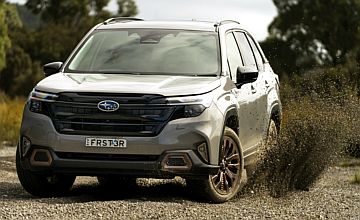Make / Model Search
OptionsCar reviews - Subaru - ForesterSubaru modelsOverviewWe like No nonsense AWD system; generous ground clearance; power and economy of Strong Hybrid driveline; sensible packaging and HMI; responsive steering; sharp dynamics; supportive front seats Room for improvement Conspicuous road noise; thirsty and somewhat sluggish petrol driveline; familiar styling inside and out; no spare wheel for hybrid models; cabin still feels more utilitarian than most segment rivals It’s been a long wait for Aussie customers, but the sixth-gen Forester finally here21 Jul 2025 By MATT BROGAN IT HAS been almost two years since Subaru debuted its sixth generation Forester at the Los Angeles Auto Show, the model finally entering the Australasian market this month with pricing from $43,490 plus on-road costs – or $4800 more than the outgoing model.
Carried over from the outgoing model is the same basic platform as before (though modified with increased weld points and additional structural adhesive - the FB-series 2.5-litre four-cylinder petrol engine, symmetrical all-wheel drive system, X-tronic continuously variable suspension, X-Mode AWD traction control, the majority of the vehicle’s suspension components, and a human-machine interface (HMI) that is largely familiar to other models in the range.
What’s new is vastly improved front seating, an increase in noise suppression materials, a dual pinion steering system borrowed from the WRX, revised exterior styling, updated Eyesight safety technologies, a more cohesive selection of cabin materials, improved aerodynamics, and an updated selection of alloy wheels.
Seven variants are available from kick-off with petrol and petrol-electric hybrid drivelines on offer. The model range offers 220mm of ground clearance, enhanced suspension tuning, all-wheel disc brakes, and is “purpose-built to tackle Australian roads and terrain with confidence”, according to Subaru Australia.
The Forester will continue to compete against original foes like the Toyota RAV4, Nissan X-Trail, and Honda CR-V alongside no fewer than 20 other entrants that now occupy the Medium SUV under $60K segment.
Of key interest to the “all-new” Forester is Subaru’s Strong Hybrid powertrain combining an Atkinson/Miller cycle 2.5-litre petrol with a Toyota-sourced 90kW electric motor and 1.1kWh battery to offer up 145kW of system output, or 31.8 per cent more than the preceding mild-hybrid offering.
The Strong Hybrid powertrain uses a planetary gear set transmission instead of the chain-driven CVT found in petrol – which is good for 136kW/247Nm output.
Fuel consumption figures quoted are 7.9 litres/100km for the petrol and 6.2L/100km for the heavier hybrid. Braked towing capacities are 1800kg for the petrol models and 1200kg for the hybrids.
Subaru Australia says the next-generation Forester is the strongest, smartest and most capable iteration yet “re-engineered to deliver greater everyday usability, enhanced efficiency, and even more confidence on and off the road”.
The line-up features four petrol-only variants: Forester AWD, AWD Premium, AWD Sport and AWD Touring, and three powered by Subaru’s “most advanced hybrid powertrain yet”, the Forester AWD Hybrid, AWD Hybrid Sport and AWD Hybrid Touring.
As anticipated, all variants utilise Subaru’s Symmetrical All-Wheel Drive that delivers constant (mechanical) traction to all four wheels for all-weather control.
Inside, the five-seat cabin is remodelled to elevate comfort, connectivity, and cabin refinement with features including an 11.6-inch infotainment touchscreen with wireless Apple CarPlay and Android Auto connectivity, Qi wireless smartphone charging pad, 12.3-inch digital driver display (on select hybrid variants), 360-degree Surround View Monitor, uprated cabin insulation and vibration damping for reduced interior noise, and ergonomic front seating for added support and comfort.
Headlining the vehicle’s safety is Subaru’s latest-generation EyeSight Driver Assist technology that is now standard across all models featuring a new wide-angle monocular camera offering a wider field of view.
Also in the safety package is a new emergency driving stop system, Subaru Vision Assist, a (somewhat pesky) driver monitoring system, and nine airbags.
On the outside, the Forester offers as standard 18-inch alloy wheels, dusk-sensing self-levelling LED headlights, front cornering lights, front and rear wipers with front de-icer, front LED fog lights, rear LED fog light, F-O-R-E-S-T-E-R embossed rear garnish, roof rails, a rear spoiler, and steering responsive headlights.
The entry model is further equipped with cloth seat trim, dual-zone climate control with rear vents, a leather steering wheel with silver stitching, auto-dimming rear-view mirror, heated front seats, one-touch electronic folding rear seats, 60:40 split folding rear seats, and a comprehensive array of entertainment, technology and safety features (but with no native sat nav or driver monitoring system).
Subaru offers a five-year/unlimited-kilometre warranty on the Forester with an included capped-price servicing plan. Scheduled service intervals are pegged at 12 months or 15,000km (whichever comes first) with pricing for the five-year period tallying a rather expensive $2299.
Complimentary 24/7 roadside assistance is included for the first 12 months of ownership.
Driving Impressions
A great number of Medium segment SUVs seem to overlook the ‘utility’ part of their descriptor, instead feeling like over-inflated hatchbacks with no more off-road cred than the average Volkswagen Golf.
Look across the growing list of high-riding family haulers and it’s the Subaru Forester than stands tall with a utilitarian cabin, exceptional ground clearance, and no-nonsense AWD system.
While most city-dwellers are unlikely to fully appreciate those benefits, rural buyers – and those with more active lifestyles – are certain to appreciate the breadth of capabilities the Forester offers, as did we on a recent launch drive outside of Christchurch, New Zealand.
Stepping into the Forester we are pleased to find a familiar layout; albeit one that shows a greater sense of uniformity in its décor. Material choices are more uniform, but still hard-wearing (read: largely plasticky) when viewed against the majority in this segment.
Seating quality is greatly improved with more support for the hips and lower back, while the human-machine interface (HMI) is sensibly presented, allowing easy access to frequently accessed controls.
Further back, there is a generous level of passenger space with a large glasshouse and sensible shoulder line providing an excellent view out. The rear seats sit slightly higher than the front to offer a good view ahead – past now narrower front seat head restraints.
Split-fold seats and a large tailgate aperture make the most of the Forester’s cargo bay – though it’s disappointing that packaging constraints mean there’s no full-size spare on the hybrid side of the fence. The roof-mounted centre seatbelt may also prove a bother for some.
On the move, the Forester feels quieter, but not to the extent of some of the best in this class. Road noise is appreciably greater over coarser surfaces and unsealed tracks, as was a hint of wind rustle from the wing mirrors when cruising at freeway speeds. On the plus side, mechanical noise is very well attenuated.
We sampled the petrol and hybrid drivelines back-to-back over a predominantly rural drive loop, including a stint on gnarly farm tracks caked in mud and strewn with loose aggregate. Here, the Forester’s no nonsense mechanical all-wheel drive system proved beyond reproach, the level of instantaneous grip available offering traction in spades.
The chassis is decidedly well calibrated to use both on- and off the beaten track. Where the average mid-sized SUV would shake itself to pieces, the Forester remains unfazed. Low-speed ride quality over the rough stuff is terrific, the dampers working well to maintain wheel pressure so as not to lose grip.
Subaru’s dual pinion steering is keen and light. The ‘wheel action is accurate and brilliantly consistent, building naturally as speed increases while being unperturbed by potholes, jolts, and other inputs. Coupled with a taut front-end – and stiffer body – the arrangement gives the Forester an athletic edge that’s both welcomed and reassuring.
With excellent body control the Forester feels as if it deserves a few more horsepower. While Subaru says the Strong Hybrid is powerful enough for now, it’s obvious the chassis can handle more, leaving the door wide open to an XT or turbocharged variant down the track.
For now, though, it’s the Strong Hybrid that’s our pick of the pair. Where the petrol is a little doughy and certainly thirstier – even with the improved ratio spread of the CVT – the hybrid offering is cleaner in its acceleration with effective regenerative braking adding to a sense of sportiness.
The electric motor assists in whittling down fuel consumption too, the Strong Hybrid recording a 6.5 litre per 100km average on our drive loop against an 8.9L/100km effort from the petrol. Given both vehicles were driven largely on the open road and with considerable time on farm trails, it’s expected those figures will be representative of what you should expect in mixed city/highway use.
While there are a lot of SUVs to choose from, particularly in the Medium end of the segment, there are very few that will match the Forester’s all-round capability and ease of use. While the driver monitoring system is a little nervous, we found the rest of the ADAS technologies a pleasure to use, ditto the infotainment screen and instrument panel.
In an era when so many vehicles make daily operation a chore, it’s pleasing to drive one that feels this sorted and sane. Sure, it may not be the most exciting vehicle for the money, but it’s certainly one that does everything a family buyer should expect, while having the added benefit of being able to get where the others can’t.  Read more30th of May 2025  Subaru prices new-gen Forester rangeSeven-variant Subaru Forester SUV arrives next month priced from $43,490 + ORCs19th of May 2025  Wagon trail for Toyota with bZ4X TouringBattery electric, all-wheel drive 280kW bZ4X Touring will be quickest Toyota SUV yetAll car reviews Alfa Romeo Alfa Romeo Abarth Abarth Audi Audi Aston Martin Aston Martin BMW BMW Bentley Bentley Chrysler Chrysler Chevrolet Chevrolet Dodge Dodge Citroen Citroen Ferrari Ferrari DS DS Ford Ford Fiat Fiat FPV FPV Foton Foton Haval Haval Great Wall Great Wall Honda Honda Holden Holden Hyundai Hyundai HSV HSV Isuzu Isuzu Infiniti Infiniti Jaguar Jaguar Iveco Iveco Kia Kia Jeep Jeep Land Rover Land Rover Lamborghini Lamborghini Maserati Maserati Lexus Lexus McLaren McLaren Mazda Mazda Mercedes-Benz Mercedes-Benz Mitsubishi Mitsubishi Mini Mini Opel Opel Nissan Nissan Porsche Porsche Peugeot Peugeot Ram Ram Proton Proton Rolls-Royce Rolls-Royce Renault Renault Skoda Skoda Saab Saab SsangYong SsangYong Smart Smart Suzuki Suzuki Subaru Subaru Toyota Toyota Tesla Tesla Volvo Volvo |
OptionsClick to share
|











Facebook Twitter Instagram